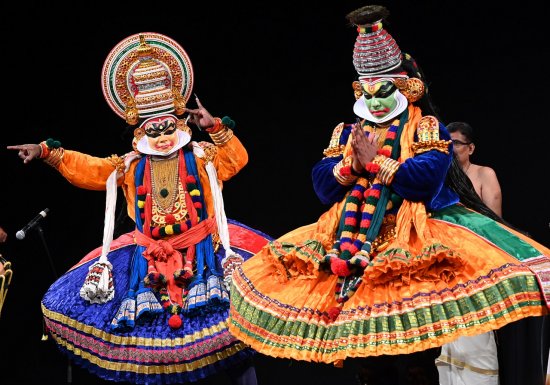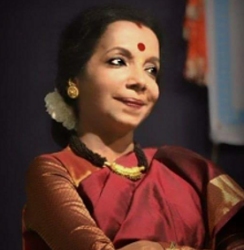
|   |

|   |
A wedding to cherish as Art - Dr. Lata Surendra e-mail: latasurendra@hotmail.com Photos courtesy: NCPA September 8, 2024 Subhadra Haranam Experimental theatre - NCPA, Mumbai, August 22, 2024 Presented by Kerala Kalamandalam Music they say is truly the door to the divine. The invocation in the background, with the Vilaku (brass lamp) endorsing the witnessing divinity, with the resounding Arrangu Keli - the beats played on a maddalam and chenda drum invoking the gods, the Tirasheiela (hand held satin curtain) at the front on the stage representing Maya, the state of illusion, one was at once transported to the temple shrines of Kerala. The curtaining Tirasheela reminiscent of the closed doors of the temple shrine, behind which the priest anointed and adorned the images of the gods with the vadyam in the background repainting the heart with hope and optimism, created an anticipation, stirring a tangible divinity in the penury of one's being, with an expectancy of a revelation about to be accorded. Thus it was that the audience awaited for the ceremonious folds of illusion to unfold with the maddalam and propitious prayer to partake of the divine marriage of Arjuna and Subhadra draped in the 400 year old traditional dance form of Kathakali - an aesthetic combination of dance, theatre, music, percussion. Based on the Vadakkan, northern text by Manthredathu Nambudiripad (1851-1906), the story of Subhadra Haranam - abduction of Subhadra, slowly unfolded before rasikas as a chain of events commencing with the wedding, the gossip of the Brahmins, Balarama's explosive anger and Krishna awakening him to Arjuna's prowess as a valiant warrior and the ideal husband for their sister Subhadra. The curtain moved away and in the lighted shadows one saw enframed Subhadra in the assured embrace of the confident and valiant male -Arjuna. The wedding of Arjuna and Subhadra is perhaps the most visually beautiful presentation of a wedding scene in Kathakali. The scene also had the mastermind Krishna and Arjuna's father Indra looking on. This scene is specifically known as 'Maalayital' - means 'exchanging of garland'. In the stillness of a quiet moment, a subtle dance unfolds - an intricate choreography of tranquility that captivates the senses and holds the viewer. Kathakali endorses this absolutely. Kathakali will have main characters exploring the lyrical content very leisurely unlike other classical dance forms. One needed to connect with that equanimity within to resonate with the artiste through the bridging metaphor of gestures, the subtle nuances of expression portrayed, if only to gather the 'moving stillness' intense and shaping like a dewdrop at the tip of a leaf, embracing the coloring meanings of transient life, intent in its gently shaping perfection.  The spectacular wedding To ardent Kathakali fans, the perfection of the powerful purusha that is Arjuna renders life-like qualities unto his character. Proximity is felt towards the artiste as his character becomes an ultimate form and an ideal of a unique individual aesthetic experience embodying the power of romance. The artistry of Kalamandalam Shanmughan as Arjuna was evident even in the post wedding moment, where in an absolutely static position for what seemed an eternity, he surveyed the scene before him, with Krishna and Indra seated and observing him. He had the attention of the entire audience, intent on his unfaltering gaze! His succumbing to the urge of reaching out to hold Subhadra's hands close to his heart and his eyes locking for a brief moment with the all knowing Krishna by the veteran Kalamandalam Dr Sudeepmohan, his peevish look at realizing his impulsive exhibition of love, are moments that a regular rasika of Kathakali who has seen Subhadra Haranam before expects and waits for. The spectacular scene concluded with Arjuna paying his respects to Krishna and his father Indra and the Devas showering petals from the heavens blessing the couple. Although as Indra, that was the last one saw of Kalamandalam Sai Karthik, his presence endorsed the sanctity of the wedding of the noble warrior Arjuna whose father he was.  'Why the modesty, my beloved?' - Arjuna and Subhadra Kalamandalam Shanmughan as Arjuna came into his own while expressing his love for Subhadra and the resurging desire within him seeking to make her his own. The greatest distance in this world it is said is not that between life and death but it is when two hearts in love are before each other. One's heart went out to Arjuna in the slow paced padam, kanchadala lochane, manjuthara bhashini, in ragam Kamboji .The portrayal of emotions between Arjuna and Subhadra is a poignant moment in Kathakali and the subtitles would have had the eyes in a dilemma - 'to read or see'. The artiste absolutely excelled as Arjuna, as he etched visually the lotus petal eyes of his consort, her proud gait majestic as the elephant. His urging her to shun her modest behavior to stop gazing at her feet to look into his eyes stole viewer's hearts. In fact it almost had one wish for the 'honey tongued beautiful' Subhadra to be more responsive, if only to compliment the inherent artistry of the Arjuna before us. Nevertheless, for most of the audience intent on subtitles that were displayed, the wanting in the poetry of the body did not seem to matter at all as they related to the poetry of words! The scene concluded with the couple leaving for Indraprastha.  Arjuna, the valiant one It was with a smile that I watched the modest Subhadra taking charge of the whip to drive the chariot and Arjuna majestic with his bow and arrow ready for the adventure ahead. The relevance of the moment is vital in the twenty-first century as the new generation is ardently trying to break stereotypes or create fresh dialogues of the feminine as the weaker sex in mythologies. In fact, here was manifest a Subhadra, the weakness and strength of her Arjuna scoffing at statements underlining the limitations of binary ideas of masculine and feminine. It was the entry of Kalamandalam Thulasikumar as Balarama that lifted the evening to glorious heights, the anger and disgust increasingly showing on his fiery countenance as he hears loose talk about Arjuna having abducted his sister. A scene impacts absolutely when two artistes complement each other in the chain of action and reaction. The evocative reactions of Kalamandalam Dr Sudeepmohan as Krishna at first going along with his brother, then feigning innocence endeared him to the audience. One could hear soft chuckles as Krishna impishly stands as Balarama accuses him of having masterminded the plot. His addressed anger questioning Krishna - 'Kuthra vada Kuthra vada - Where is he? I will kill this enemy in no time' - created a tempo that had lyrics, feelings and chords resonate as vibrations induced through the transformative artistry of Kalamandalam Thulasikumar won hearts all around. Sudeepmohan excelled as Krishna in his calming of Balarama's rage. His logical highlighting of the fact that any rash act on their part would find their sister as a widow, his urging of Balarama to meet Arjuna, the valiant husband of their sister, his indulging him at first and later convincing him to meet Arjuna showcased an experience complimenting the part absolutely. No subtitles were needed in the eloquence that had artistry transcend the limitation of words.  Krishna and Balarama It was sheer delight to see an eager Krishna affirming sincerely, meekly and eagerly the expressed praise of Arjuna, the warrior, by his elder brother. A happy conclusion it was with 'all's well that ends well' and with the interwoven movement patterns of the ashtakalasam set to complex rhythm cycles in three variations of tempo, the evening gathered its climax, complimented with a standing ovation by all present. The ovation and cheers were as much for the artistes as for the NCPA and Programme Head - Dance, Dr Swapnokalpa Dasgupta, for a successful dance residency that sought to give a voice unto Kathakali and enlarge its reach to art lovers of Mumbai city. The accompanying artistes were: Vocals - Kalamandalam Vinod and Kalamandalam Hareesh, chenda - Kalamandalam Unnikrishnan, maddalam- Kalamandalam Hariharan. Chutty was by Kalamandalam Sivadas and Kalamandalam Dhiginraj, costumes by Ramesh & Arun O V. Kathakali absolutely awakens one to the patience within us, the flowing eternity between 'then and now', to receive with the timeless in our hearts. It awakens us to the power of silence as an empowering tool through characters, knowing when to listen intently, when to speak with silent eloquence, when to harmonize our lives with the symphony of existence. Within the art of silence lies a timeless truth that profound messages whisper, and the greatest transformations occur within the stillness of our hearts through the cathartic folds of Art.  Dr. Lata Surendra is a performer, mentor, an imaginative choreographer, a sought after curator, a dance journalist, a committed independent researcher, a sensitive poet and in the field of dance for over six decades. |